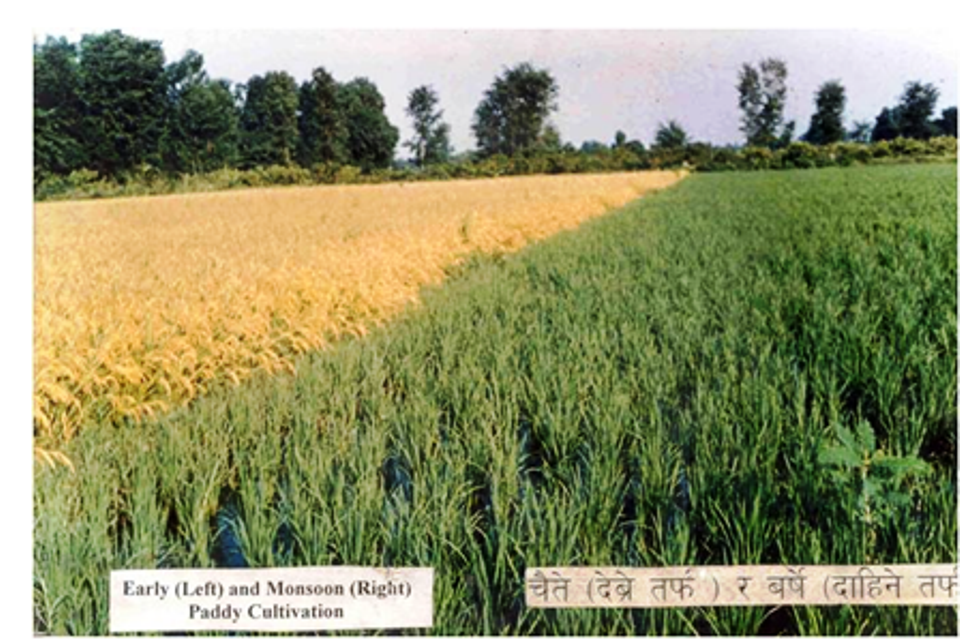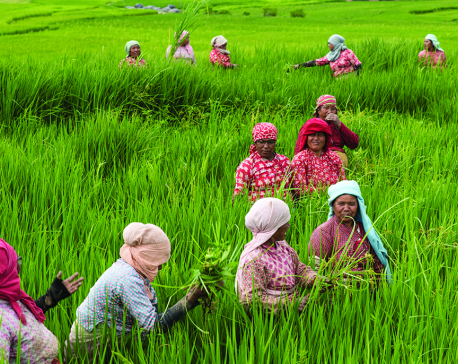
OR
#National Rice Day

More from Author
The system of rice intensification (SRI) is another agronomic manipulation which can increase rice yield. The plant growth regulators (PGRs) can also be used for increasing rice productivity. However, we should not forget the environmentally-friendly and sustainability issues while increasing productivity and production.
Rice scenario
Today, Nepal is observing the 18th National Rice Day and Transplanting Festival with the theme “Increase in Rice Production: Food Security, Self-sufficiency and Prosperity”. Rice is the predominant cereal crop in South Asia and Nepal. As per the estimate of Fiscal Year 2020/2021, the rice crop was grown in 1,473,500 hectares with the production of 5,621,000 metric tons and the productivity was 3.815 ton/ha. There are fewer possibilities of bringing more land area into production. Therefore, we have to increase the productivity per hectare per day by knowledge -, science-, technology and innovation-based farming. The promising rice varieties plus successful technologies generated by agricultural research play a pivotal role.
Nepal so far has released and registered 96 improved rice varieties (including two hybrids) with a full package of practices within the span of 55 years. The coverage by improved rice varieties in Nepal is approximately 97 percent. Some of the popular rice varieties among farmers are Radha-4, Radha-12, Sabitri, Hardinath-1, Sukkadhan 3, Chaite-5 in Tarai, Khumal-4, Khumal-11, Chainung-242 in the mid-hills and Chandannath-3, Lekali 1, Lekali 3 in the high hills. Nepal is also the country where rice is cultivated at the highest altitude (9,000-10,000 ft) in the world (Chhumchaur, Jumla).
Increasing yield
The modern varieties can express their yield potentiality only when recommended packages are practiced. Quality seeds alone can contribute to increased yield by 15-20 percent. Seed selection can be done by following the specific gravity principle. Early paddy and Boro (winter) rice can be used for increasing rice yield by utilizing the higher intensity of solar radiation i.e. using sun to end hunger or enhance/boost rice productivity.
The system of rice intensification (SRI) is another agronomic manipulation which can increase rice yield. The plant growth regulators (PGRs) can also be used for increasing rice productivity. However, we should not forget the environmentally-friendly and sustainability issues while increasing productivity and production. That is why these days we say "Evergreen Revolution" and not "Green Revolution". It is said "Grow paddy with soil fertility, wheat with fertilizers" and also "Healthy seedlings are responsible for at least half of the yields”.
Asar 15
The author of this article was instrumental in declaring the 15th day of the Nepali month of Asadh (Asar 15), the day culturally known for eating curd/yoghurt and beaten rice in Nepal, as the "National Rice Day" by the Nepal government. Nepal is celebrating the 18th National Rice Day and Transplanting Festival on 15th of Asar 2078BS (29th June 2021). Because of the good performance of Nepal during the International Year of Rice - 2004, the Philippines-based International Rice Research Institute (IRRI) in its Rice Today (Vol.3, No.3, 2004) had written one article mentioning "Year Achieves High-Profile in Nepal ".
Nepal’s major cropRice contributes more than 50 percent to Nepal’s total food. So, rice security is food security in Nepal. The national economy depends on rice production itself. For example, as per the data released by the International Monetary Fund (IMF), the GDP growth of Nepal in the fiscal year 2016-2017 and 2018-2019 was 6.5 percent and 7.1 percent respectively. There is approximately 21 percent share of rice in Nepal's agricultural GDP and seven percent in the national GDP.
Rice is one of the most important and number one cereal crops in Nepal. Not only is rice a key source of food, but it is also a major employer and source of income for the poor. The world food problem is created because of urbanization, crop diversification, fallow land, low investment in agricultural research and development, climate change, conversion of food crops like maize into bio-fuels. China has banned the conversion of maize into bio-fuels. Rice is also the staple food for more than 50 percent of the world's population (3.5 billion). Moreover, more than 90 percent of rice is produced as well as consumed in Asian countries. So, the trade of rice is only about six to eight percent. China and India used to produce about 50 percent of Asia's rice. So, rice brings the Asians together. The present global rice production is about 509 million tons. In 2007-2008, there was a global food crisis but a few months later the global financial crisis emerged and it eclipsed the food crisis.
Some facts
Our constitution guarantees the people’s right to food as well. The United Nations Organization (UNO) declared 2004, as the "International Year of Rice" with the theme "Rice is Life". The Government of Nepal after 2004 also had declared the 15th day of the Nepali month of Asar as the “National Rice Day”. The United Nations also declared Rice as the “Crop of the Year” in 1966 with the theme “Freedom from Hunger”. Because, back in those times, “hunger was a big story in Asia”. There are fewer possibilities of bringing more land into production. Therefore, we have to increase the productivity per hectare per day by the successful technological interventions. The internal rate of return (IRR) in agriculture research is very high. It is said: to get success, there should be a "research push and a market pull". Rice seeds can be selected based on the principle of specific gravity. Early paddy and Boro (winter) rice can be used for increasing rice yield by utilizing higher intensity of solar radiation especially after flowering. The system of rice intensification (SRI) is another way of agronomic manipulation which can increase rice yield.
The donors’ priority during the Maoist insurgency in Nepal was peace. But they can't bypass the agriculture sector because “a hungry man is no peaceful man", "a hungry stomach is a restless one" and “a hungry man is an angry man”.
Had the yield of rice remained at its pre-green revolution (1966-1967) level of 1.9 t/ha, the current production would have required more than double the current rice land area and 50 percent of the forest areas would have been reduced. In theory, three to five thousand liters of water is needed to produce one kilogram of paddy. Drought tolerant rice varieties consuming less water, such as Sukkhadhan 1, Sukkhadhan 2, Sukkhadhan 3, Sukkhadhan 4, Sukkhadhan 5, Sukkhadhan 6 (both for drought and submerged conditions) rice varieties are already recommended for drought conditions and Swarna Sub1, Sambha Masuli Sub1 and Ciherang Sub1 are for submerged conditions. Agronomical manipulations are needed to combat global warming. For example, rice seedlings raised in dry seed beds can tolerate drought as compared to wet seed bed’s seedlings. The food security, nutrition security, profitability and sustainability are the major issues at present and future agriculture.
Conclusion
Last but not the least, because of global food issues and increased food prices, the author of this article would like to strongly request the Government of Nepal to form immediately a High-level National Food Security Mission, involving field-hardened experts with proven track-record too including concrete plan of action with fixed priorities and assured budgetary allocation so as to cope with the burning problem of shortage of food grains in the country. Food self-sufficiency is the urgent demand of the present times. The Government of India during the last global food crisis had banned the export of wheat and non-basmati rice in 2007-08 for four years. If Nepal is not self-reliant in food grains, a situation like of 2007-08 may come where we may not buy rice even if we have money in our pockets. [The author is a senior rice expert who served at Nepal Agricultural Research Council (NARC)].
You May Like This

Road to commercialization
If Nepal is to speed-up agricultural commercialization process for both import substitution and export promotion, there is no better way... Read More...

Building safe homes
Local governments should take initiative for implementing building codes and by-laws. They should also monitor compliance of those laws ... Read More...

Bad news for women
The media have a responsibility to reflect society not only as it is, but also as it should be. This... Read More...





Just In
- MoHP cautions docs working in govt hospitals not to work in private ones
- Over 400,000 tourists visited Mustang by road last year
- 19 hydropower projects to be showcased at investment summit
- Global oil and gold prices surge as Israel retaliates against Iran
- Sajha Yatayat cancels CEO appointment process for lack of candidates
- Govt padlocks Nepal Scouts’ property illegally occupied by NC lawmaker Deepak Khadka
- FWEAN meets with President Paudel to solicit support for women entrepreneurship
- Koshi provincial assembly passes resolution motion calling for special session by majority votes







_20220508065243.jpg)






Leave A Comment